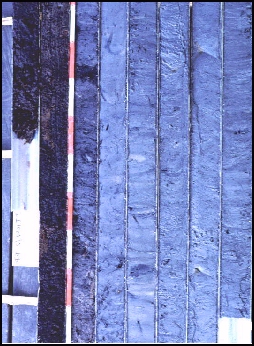

The accumulation of peat, the precursor to coal, occurs in settings where there is a high water-table. This prohibits the flow of organic acids, leached from rotting vegetation, away from the depositional site. A decrease in pH, and accompanying changes in Eh, prevent bacterial colonization, prohibiting extensive degradation by decomposers. Mires (general term adopted for peat-forming ecosystems) are the main site in which peat may accumulate:



Dry weights of plant materials are dependent upon the specific organ (e.g. leaves 10%; wood 50%) and their contribution to the accumulated detritus is accordingly. Decomposition continues by microorganisms whereby the carbohydrates are used for metabolism and growth, and proteins used for growth. This process is not responsible for Carbon enrichment.
Aerobic Peatification (decay in oxygen environments) consists of two processes:
Anaerobic Peatification (decay in oxygenless environments and biomethanization) is facilitated by:
Overall, this results in the decrease in cellulose and increase in LIGNIN. CELLULOSE is a linear macromolecule depolymerized by hydrolysis to glucose.
LIGNINS are alcohols, polymers or mixed polymers of monomer alcohols differing in methoxyl content (-OCH3). LIGNINS comprise up to 70% of the middle lamella of cells, and in bark may comprise 25% of the entire cell!
The rate & ratio of cellulose:lignin decomposition:degradation are dependent on the depositional environment.
As volatile matter decreases, fixed Carbon increases with depth of burial (Hilt's Law). The rank of the coal is measured by C:O2 content, volatile matter, and moisture.
| RANK | ASTM | %Carbon | Volatiles | Calories/lb |
| Peat | 60 | |||
| Soft Brown | Brown coal | 53 | 4000 | |
| Hard Brown | Lignite | <71 | >49 | 5300 |
| Hard Coal | SubBituminous
Low (High Vol) Medium Volatile Low Volatile |
<77 <87 |
>42 >29 |
7000 8630 |
| Anthracite | <91 | >8 | 8630 |
Macroscopically coal can be subdivided into various components that reflect the coalification processes. These result either in a HUMIC (terrestrial plant part derived) or SAPROPELIC (lake-aquatic derived) coal. The principal macerals of these coals are:
This group maceral represents cell walls of trunks, branches, roots, etc. (telinite); along with the reprecipitation of dissolved organic matter in a "gel" form (collinite); and fragments of vitrinite (vitrodetrite).
These include mega- and microspores (sporinite); cuticles (cutinite); plant resins, waxes and other secretions (resinite); algae (alginite) anddegradation residues (liptodetrinite).
These include oxidized plant material that may be the result of fire (fusinite); aerobically oxidized plant parts (semifusinite); oxidized "gel" material (macrinite); reworked inertinites (inertodetinite); and fungal remains (sclerotinite).
When these macerals are combined together, they comprise specific lithotypes of the coal. These lithotypes include:
Black, very bright lustre, thin layers that break cubically, thicker layers have a conchoidal fracture pattern.
Finely stratified layers of vitrain, durain, and, in some cases, fusain. Medium lustre.
Black or gray, dull, rough fracture surfaces and composed of mineral matter.
Black, silky luster, friable and soft. Appears like charcoal because it is fossilized charcoal.
Black, dull with a luster that may appear greasy. Coal breaks with a conchoidal fracture. Macerals are fine and dominated by exinites, particularly sporinite.
Black or brown, dull, homogenous, breaks with a conchoidal fracture and a greasy luster. The coal is dominated by alginite.
Where the residuals of terrestrial plants are not concentrated in a peat, they may occur as viscous impregnations of sandstone, siltstone, shale and carbonate rocks. These residues are known as BITUMENS. Bitumens are the soluable fraction and the precursors for liquid petroleum, asphalts (residuals of crude oil), mineral waxes, etc. The insoluable fraction result in KEROGENS (yields oil by pyrolysis) and PYROBITUMENS (extracted from coals/lignites).
The chemical constituents of organic matter react to thermal maturation, and there is a change in color of the organic debris with increasing temperature. Photometers are used to measure the thin-walled portions of spores to determine the shift in coloration (and flourescence). As the thermal index increases, there is a shift to the red end of the spectrum.
| FACIES | TEMPERATURE | COAL RANK | COLOR & THERMAL INDEX |
| Immature | Peat/Brown Coal | Greenish-yellow 1.5 | |
| Transition | 32-65C | Lignite/Sub-Bituminous | Pale yellow-yellow 2.0 |
| Mature | 100C | High Vol. Bituminous | Amber 2.5 |
| Transition | 120-170C | Med. Vol. Bituminous | Amber 2.7 |
|
Metamorphosed |
200C |
Low Vol. Bituminous |
Deep Red Brown 3.0 |
| Brown Black 3.2 | |||
| Black 3.5 | |||
| Black-Opaque +/-4.0 | |||
| Phyllite | 316C+ | Black-Opaque +/-4.0 | |
| Graphite | Black-Opaque +/- 5.0 |